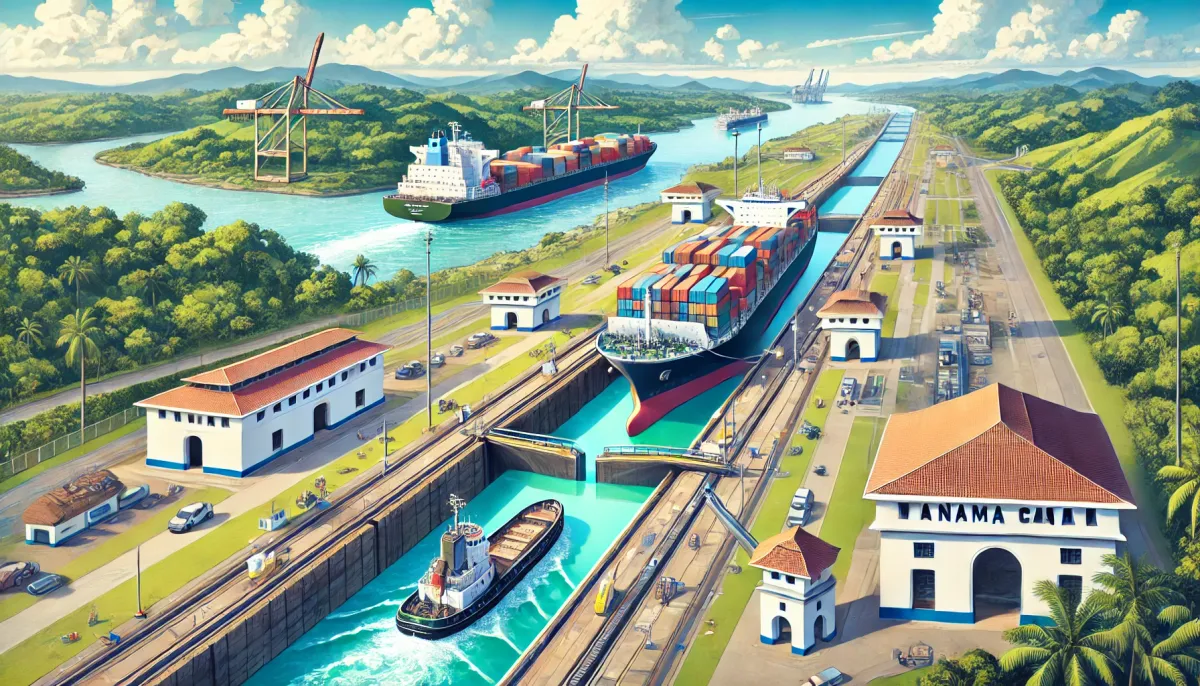Trends in Panama Canal Shipping Traffic
Explore the latest trends in Panama Canal shipping traffic, including daily and annual ship passages, key factors influencing volume, and the canal's strategic economic and geopolitical significance in global trade.

Introduction
The Panama Canal, a marvel of modern engineering, serves as a vital artery in global maritime trade. It connects the Atlantic and Pacific Oceans, offering a shortcut that significantly reduces the travel distance and time for ships that would otherwise navigate the treacherous waters of Cape Horn. In this article, we explore the trends in Panama Canal shipping traffic, delving into statistics on daily and annual ship passages, and examining the various factors influencing these patterns.
The Significance of the Panama Canal
Opened in 1914, the Panama Canal has been instrumental in shaping global trade routes. Its strategic location and ability to accommodate a wide range of vessels make it a critical component of international shipping. By facilitating the movement of goods between the world's largest oceans, the canal plays a pivotal role in the global supply chain, influencing the economies of countless nations.
Historical Context and Construction
The construction of the Panama Canal was a monumental undertaking that took over a decade to complete. The challenges faced during its construction, from disease to engineering hurdles, are a testament to human ingenuity and perseverance. The canal's opening in 1914 marked the beginning of a new era in global trade, drastically reducing the time and cost associated with maritime shipping.
Strategic Geopolitical Importance
The Panama Canal is not just an engineering feat but a strategic geopolitical asset. It has been at the center of international diplomacy and conflict, influencing global power dynamics. Control and management of the canal have historically been of interest to major world powers due to its critical role in international trade.
Economic Impact on Global Trade
The economic impact of the Panama Canal extends far beyond the borders of Panama. It serves as a crucial link in the global supply chain, affecting shipping costs, transit times, and trade balances. The canal's operations generate significant revenue for Panama and contribute to the economic stability of nations that rely heavily on maritime trade.
Daily and Annual Ship Traffic
How Many Ships Pass Through the Panama Canal Daily?
The Panama Canal Authority (ACP) manages and oversees the operations of the canal, providing precise data on ship traffic. On average, approximately 35 to 40 ships traverse the canal each day. This figure, however, can fluctuate based on various factors such as weather conditions, maintenance schedules, and global economic trends.
Factors Affecting Daily Traffic Volume
Daily traffic volume through the Panama Canal is influenced by several dynamic factors. Weather conditions, such as tropical storms or heavy rainfall, can temporarily halt or slow down transit operations. Scheduled maintenance of the locks and channels is another critical factor, often planned to minimize disruptions but still impacting daily throughput.
Seasonal Variations in Traffic
Traffic through the canal can also exhibit seasonal variations. Certain times of the year, such as the peak shipping season before major holidays, can see increased activity. Conversely, periods of economic slowdown or global disruptions, like pandemics, can lead to decreased daily traffic.
Operational Strategies for Traffic Management
The ACP employs various strategies to manage and optimize daily ship traffic. These include advanced scheduling systems, real-time monitoring of vessel positions, and coordination with shipping companies to ensure smooth passage. These strategies are vital to maintaining the canal's efficiency and reliability as a key maritime route.
How Many Ships Pass Through the Panama Canal Each Year?
Annually, the canal facilitates the passage of about 13,000 to 14,000 vessels. This translates to over 200 million tons of cargo transported through this strategic waterway each year. The range of vessels includes container ships, bulk carriers, oil tankers, and cruise ships, each playing a distinct role in the movement of global goods and commodities.
Diversity of Vessels and Cargo
The Panama Canal accommodates a diverse array of vessels, each carrying different types of cargo. Container ships transport consumer goods, electronics, and machinery, while bulk carriers handle raw materials like grain and coal. Oil tankers and cruise ships also make regular transits, each contributing uniquely to the canal's annual traffic statistics.
Long-Term Trends in Annual Traffic
Examining long-term trends in annual traffic reveals insights into global trade patterns. Periods of economic growth or recession, changes in consumer demand, and geopolitical shifts can all influence the number of vessels using the canal. Understanding these trends helps stakeholders make informed decisions about shipping routes and investments.
Impact of Global Events on Annual Traffic
Global events, such as economic crises or pandemics, can have profound impacts on annual canal traffic. During the COVID-19 pandemic, for example, there was a noticeable dip in shipping volumes, reflecting disruptions in global supply chains. Conversely, economic recoveries often lead to surges in traffic as trade activity rebounds.
Factors Influencing Canal Traffic
Economic Trends
Global economic conditions have a profound impact on Panama Canal shipping traffic. During periods of economic growth, there is typically an increase in the volume of goods transported, leading to heightened canal traffic. Conversely, economic downturns can result in reduced shipping activity as global trade volumes decline.
Impact of Economic Cycles
Economic cycles, characterized by periods of expansion and contraction, directly influence shipping volumes. During expansions, increased production and consumption drive up the demand for shipping services, resulting in higher canal traffic. Conversely, recessions lead to reduced demand and a corresponding drop in traffic.
Trade Agreements and Tariffs
International trade agreements and tariffs also play a significant role in shaping canal traffic. Trade deals can open new markets and routes, increasing the volume of goods transiting the canal. On the other hand, tariffs and trade barriers can discourage shipping activity, impacting the canal's throughput.
Influence of Emerging Markets
Emerging markets, particularly in Asia and Latin America, are becoming increasingly influential in global trade. As these economies grow, so does their demand for shipping services, contributing to increased traffic through the Panama Canal. The canal's strategic location makes it a preferred route for trade between these regions and major markets in Europe and North America.
Technological Advances
Advancements in shipbuilding technology have led to the development of larger, more efficient vessels. The expansion of the Panama Canal, completed in 2016, was a direct response to the growing size of these ships. The new set of locks, known as the Panama Canal Expansion or the "Third Set of Locks," allows the transit of New Panamax ships, which have significantly larger dimensions than their predecessors.
Evolution of Ship Design
The evolution of ship design has been driven by the need for greater efficiency and capacity. Modern vessels are equipped with advanced navigation systems, fuel-efficient engines, and larger cargo holds. These innovations have enabled shipping companies to reduce costs and emissions, aligning with global sustainability goals.
Impact of Automation and AI
Automation and artificial intelligence are transforming the shipping industry, including canal operations. Automated systems enhance the precision and safety of vessel transits, while AI-driven analytics optimize traffic management and maintenance schedules. The Panama Canal is leveraging these technologies to maintain its competitive edge.
Innovations in Sustainable Shipping
Sustainability is a growing focus in maritime shipping, with innovations aimed at reducing environmental impact. The Panama Canal has implemented measures such as water-saving basins and energy-efficient lighting to minimize its ecological footprint. These initiatives are part of a broader effort to promote sustainable practices in global trade.
Environmental Considerations
Increasing awareness of environmental issues has influenced shipping practices worldwide. As a result, there is a growing emphasis on reducing carbon emissions and enhancing fuel efficiency. The Panama Canal is at the forefront of these efforts, implementing initiatives aimed at minimizing environmental impact while maintaining operational efficiency.
Carbon Emission Reduction Strategies
The shipping industry is a significant contributor to global carbon emissions, prompting calls for reduction strategies. The Panama Canal has introduced incentives for vessels that meet stringent environmental standards, encouraging cleaner technologies and practices. These measures are crucial for aligning with international climate agreements.
Water Conservation Efforts
Water conservation is a critical aspect of the canal's environmental strategy. The expanded locks incorporate water-saving basins, reducing the amount of freshwater used in each transit. This innovation is essential for ensuring the canal's sustainability, particularly in the face of climate change and water scarcity.
Collaborations for Environmental Sustainability
Collaboration with international organizations and stakeholders is key to advancing environmental sustainability. The Panama Canal partners with entities such as the International Maritime Organization to promote best practices and share knowledge on reducing the maritime industry's environmental impact. These collaborations are vital for achieving global sustainability goals.
The Impact of Canal Expansion
The expansion of the Panama Canal has had a transformative effect on global shipping routes. By accommodating larger vessels, the canal has increased its capacity and competitiveness, attracting more shipping lines. This expansion has also led to shifts in trade patterns, with certain ports experiencing increased traffic due to the canal's enhanced capabilities.
Shift in Trade Routes
The ability to transit larger vessels has prompted some shipping companies to reroute their services through the Panama Canal. This has resulted in a shift in trade routes, with certain ports along the U.S. East Coast and Gulf Coast experiencing increased cargo volumes. The expanded canal has also provided an alternative route for ships traveling between Asia and the Americas, further influencing global trade dynamics.
Impact on U.S. Ports
The expansion has had a significant impact on U.S. ports, particularly those on the East and Gulf Coasts. Ports like New York, Savannah, and Houston have seen increased traffic as shipping lines capitalize on the expanded canal's capabilities. This shift has prompted infrastructure investments to accommodate larger vessels and increased cargo volumes.
Influence on Asia-America Trade
The expanded Panama Canal has become a crucial link in Asia-America trade routes, offering a more efficient path for goods traveling between these regions. This has bolstered trade relationships and increased the competitiveness of shipping lines that utilize the canal. The strategic position of the canal makes it a preferred choice for companies looking to streamline their supply chains.
Changes in Global Shipping Patterns
The expansion of the Panama Canal has led to broader changes in global shipping patterns. Shipping companies are re-evaluating their routes and fleet compositions to leverage the canal's new capabilities. This has resulted in a more dynamic and competitive maritime industry, with the canal playing a central role in shaping future trade dynamics.
Economic Implications
The economic implications of the Panama Canal expansion are far-reaching. By reducing transit times and costs, the canal has enhanced the efficiency of global supply chains. This has had a positive impact on the economies of countries reliant on maritime trade, bolstering their competitiveness in the global market.
Cost Savings for Shipping Lines
The ability to transit larger vessels through the expanded canal has resulted in significant cost savings for shipping lines. These savings stem from reduced fuel consumption, shorter transit times, and economies of scale. The financial benefits are passed on to consumers, resulting in lower prices for goods and commodities.
Boost to Panama's Economy
The expansion has also been a boon to Panama's economy, generating increased revenue from tolls and ancillary services. The canal's enhanced capabilities have attracted new business opportunities, spurring economic growth and development in the region. The expansion has solidified Panama's position as a key player in global trade.
Global Supply Chain Optimization
The Panama Canal expansion has facilitated the optimization of global supply chains, enabling more efficient movement of goods. Companies can better align their logistics strategies with the canal's capabilities, reducing lead times and improving delivery reliability. This optimization is crucial for maintaining competitiveness in a fast-paced global market.
Challenges and Future Prospects
Navigational Challenges
Despite its benefits, the Panama Canal faces several navigational challenges. The passage of larger vessels requires precise coordination and expertise to ensure safe transit through the canal's locks and waterways. The ACP continues to invest in training and technology to address these challenges, maintaining the canal's status as a premier shipping route.
Training and Skill Development
Ensuring safe and efficient navigation through the canal requires highly skilled personnel. The ACP invests heavily in training programs for pilots and operators, equipping them with the knowledge and expertise needed to manage complex transits. Continuous skill development is essential for maintaining the canal's operational standards.
Technology and Innovation in Navigation
Innovative technologies play a crucial role in overcoming navigational challenges. The ACP employs advanced navigation systems, including GPS and real-time data analytics, to enhance transit safety and efficiency. These technologies are integral to maintaining the canal's reputation as a reliable and secure maritime route.
Collaborative Efforts for Safety
Collaboration with international shipping organizations and stakeholders is key to addressing navigational challenges. The ACP works closely with industry experts to share best practices and develop new safety protocols. These collaborative efforts ensure that the canal remains at the forefront of maritime safety and efficiency.
Adapting to Climate Change
Climate change poses a significant threat to the Panama Canal's operations. Rising sea levels and changing weather patterns could impact the canal's infrastructure and operational efficiency. In response, the ACP is actively pursuing strategies to mitigate these risks, focusing on sustainability and resilience in its long-term planning.
Infrastructure Resilience and Adaptation
To address the challenges posed by climate change, the ACP is investing in infrastructure resilience and adaptation measures. These include reinforcing canal structures, upgrading water management systems, and enhancing flood protection. Such measures are crucial for safeguarding the canal's operations against climate-related disruptions.
Environmental Monitoring and Research
Environmental monitoring and research are key components of the canal's climate adaptation strategy. The ACP conducts ongoing studies to assess climate impacts and develop mitigation plans. This proactive approach ensures that the canal can respond effectively to changing environmental conditions.
Sustainability Initiatives and Partnerships
Sustainability initiatives and partnerships are at the heart of the canal's climate change strategy. The ACP collaborates with international organizations to promote sustainable practices and reduce the canal's carbon footprint. These efforts are vital for ensuring the long-term viability and environmental stewardship of the canal.
Conclusion
The Panama Canal remains a cornerstone of global maritime trade, with its strategic location and capacity to accommodate a diverse range of vessels. As shipping trends evolve, the canal's role in facilitating international commerce will continue to be of paramount importance. By understanding the factors influencing canal traffic and the impact of its expansion, stakeholders can better navigate the complexities of global trade and harness the opportunities presented by this vital waterway.
As we look to the future, the Panama Canal will undoubtedly play a crucial role in shaping the trajectory of global shipping, adapting to new challenges and driving economic growth on a global scale. Its enduring significance underscores the importance of continued investment and innovation in this essential infrastructure. The canal's commitment to sustainability and resilience will ensure that it remains a pivotal force in international trade for generations to come.

